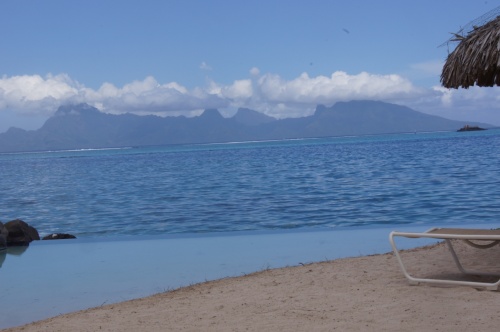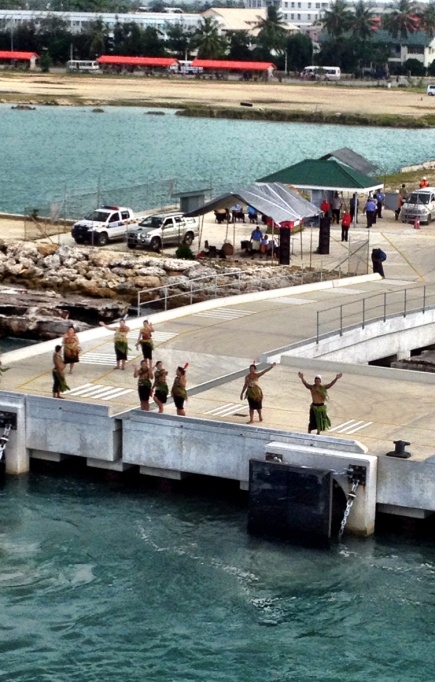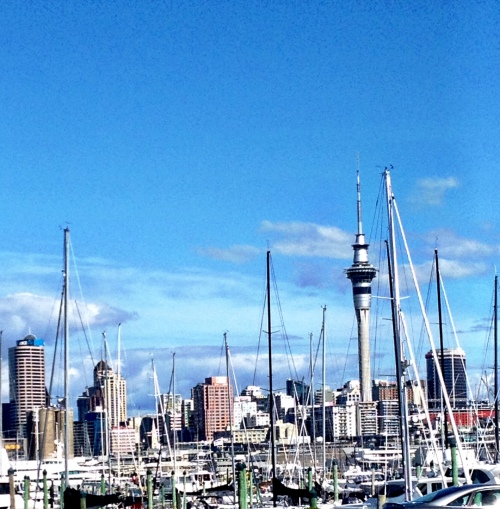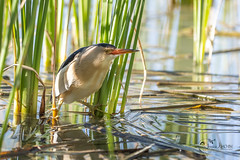Author: Lance Donaldson-Evans, Professor Emeritus of Romance Languages
I grew up just a block from the South Pacific in Newcastle, Australia, and so when I learned that Penn Alumni Travel was looking for a faculty host for a Crystal Cruises voyage from Papeete to Auckland, I was quick to volunteer and very grateful to be accepted. As I pondered the itinerary, I realized that we would be following in the wake of many famous navigators, but particularly men like Captain James Cook (no relation to the famous, but now defunct, Cooks Travel Agency), Louis-Antoine de Bougainville (who had a flower, and an island that was to become an important battleground in World War II named after him) and Jean-François de La Pérouse (who, among other things, gave his name to a suburb of Sydney). I decided this was a perfect way to combine pleasure with history and that the two talks I was to give the group would be on these 18th century sailors.
We arrived at Papeete Airport early (6:10 AM) on the morning of January 20, somewhat bleary-eyed after 8 and a half hours of sometimes bumpy flying over the Pacific from Los Angeles. It was quite hot and humid (most of the year Tahiti has a much more pleasant climate, but this was the middle of the Tahitian summer) and we were directed to the Intercontinental Hotel where a refreshing buffet of all sorts of French pastries and tropical fruits awaited us. We were able to enjoy the facilities of the hotel until 11:30 when a bus arrived to transport us to the ship. The view from the hotel grounds was idyllic, with the deep blue waters of the Pacific stretching across to the beautiful island of Moorea.

The hotel was a bustling place and we were impressed with the attire of some of the staff. If we wonder where the current fad for tattoos comes from, no need to look beyond Polynesia:

We arrived at the ship where a delicious lunch was served in the dining room, and later in the afternoon we were reunited with our luggage in our cabins. At least, almost all of us were. One unfortunate couple discovered that their bags had not been transferred in time and had to wait until the ship docked in Bora Bora next day to recover theirs. (These are the challenges of travel!)
That evening we met our AHI host, a very efficient and witty Brit by the name of John Powell (after seeing him in action one wondered if he were not a descendant of Baden Powell, founder of the Boy Scouts!). AHI is an educational tour operator that works with Penn Alumni Travel to provide enlightening and well-organized tours. We also met alums from Wisconsin, Michigan and members of the Smithsonian Institution at an AHI cocktail reception in the beautiful Palm Court Lounge on deck 11 with a wrap-around view over the Crystal Symphony’s bow. My wife Mary and I had chosen the “dinner by reservation” option, rather than a set table, in the hope we would be able to join people in the Penn group on a rotation basis. However, as Crystal cruises has an extremely loyal following and as many passengers had been on the ship since Valparaiso and were continuing on to Sydney, there was very little flexibility in dining room seating and we ended up at a table for two (fortunately, even after 45 years of marriage, we still have plenty to say to each other).
Next day, we anchored off the beautiful island of Bora Bora where we had opted for a snorkel tour with stingrays and sharks (small reef sharks, not great whites). This was very pleasant and we had the backdrop of Bora Bora, which we circumnavigated after our encounter with the aforementioned sea creatures on our way back to the ship.

On our excursion, we had, as one of our guides, a native of Bora Bora, who reminded us of the character Bloody Mary in “South Pacific,” laugh included:

After the morning excursion and some shopping for black pearls in the sleepy town of Vaitape, we were tendered back to the ship for a late dinner and then off to bed, to be rocked to sleep by the (still) gentle waves of the Pacific.
Next day was a day at sea and was when my first talk was scheduled. Mercifully the seas were slight and the lecturer (yours truly) had no problems maintaining his balance on the stage of the Hollywood Theater (as close as he’ll ever get to Hollywood, except as a tourist!) as he talked about the perils, challenges and some pleasures of maritime exploration in the 18th century in the Pacific. As jetlag hadn’t quite been conquered, some members of the group retired to their cabins for a siesta before coming to the 5:30 PM reception organized just for the Penn group in the Palm Court Lounge.

Next day we anchored off Rarotonga in the Cook Islands (yes named after that Cook, even though he never actually set foot on them).

Some of us took a 4-wheel drive excursion up into the hills in the center of this relatively small island. We motored passed picturesque farms and houses, some of which had family graves (encased in concrete) in their front yards (legal in the Cook Islands) and visited a waterfall and some sacred sites. Then a precipitous climb to a lookout from where we had a birds-eye view right down to the incredibly blue Pacific:

While less spectacular than French Polynesia, the Cook Islands have their own tropical beauty and the Cook Islanders are particularly friendly.
Next day was a day at sea as we sailed for Tonga, an independent kingdom near the International Date Line. Those of us who had signed up for a tour of Tonga had received a message that we should not expect it to be up to the standard of a normal tour, as tourism was still in its infancy in the kingdom. Surprisingly, instead of having to tender passengers to shore as had been the case in Bora Bora and Rarotonga, the ship was able to dock at a wharf on this low island (very flat with no hills to speak of), and we had a splendid view of the Victorian era royal palace, which overlooks the harbor:

We saw the blowhole, which gave a modest performance; flying foxes (large bats that are not nocturnal) and which had colonized a number of fruit trees; and a dance show, which was extremely modest in both dress and movement, compared with the rather raunchy dances in other parts of Polynesia. One suspects that the missionaries who arrived in the 19th century had done their work perhaps too well! The highlight of our day however was the wonderful sailaway sendoff we were given as we cast off from the pier. The police band gave us a concert and a group of dancers, swayed gracefully, as they sang the tear-jerking Maori farewell. Quite memorable and unique.

Our next port of call was Lautoka, Fiji, but en route, we heard the first of three fascinating talks on astronomy and the latest theories on the universe by Carolyn Petersen, the lecturer with the Smithsonian group. On our sea days, there was a great deal of activity on board, and three other lecturers (engaged by the cruise line) gave talks open to all the ship’s passengers, while, because of space constraints, our lectures were only open to the members of the AHI contingent. In some ways, our days at sea were even busier than those in port. Lautoka is on the island of Viti Levu, the largest of the Fijian Islands and by far the largest island we visited before arriving in New Zealand. Here we encountered our first real rain so far, apart from a few passing sprinkles on Rarotonga. Some had chosen the four-wheel drive adventure that would take us up into the highlands and to a typical Fijian village. This was one of the best excursions we have ever done. We were comfortably transported in air-conditioned Toyota land cruisers up some very rough roads leading up into the hills, from where we had a beautiful view of the interior of this lush island.

We then visited a village in the highlands, where we saw the church, the equivalent of the court house (where miscreants were punished) and the community hall, where we participated in a kava ceremony, some of us drinking from a coconut shell the numbing liquid of the kava tree, which had been prepared before our eyes to the accompaniment of songs and chants.


The village buildings were fairly rudimentary, and the communal toilet seemed to be no exception:

However imagine our surprise, when, on opening the door, we found a fully operational flush toilet!
On our return to the ship we visited an orchid farm and a house which had been in the hands of the same Scottish-Fijian family since the mid-19th century. By this time the rain was coming down in torrents, but it had been a wonderful excursion and we returned to Crystal Symphony delighted with our adventure.
During the last two days at sea on our way to Auckland, the Pacific showed us that it was not always true to its name. We had about 36 hours of continuous rough seas (18 feet according to the captain) as we punched into 35 knot headwinds. On the first of these days we had lunch for the Penn group in the Crystal dining room, fortunately low enough in the ship so that the ship’s movement wasn’t too disturbing, and after this we had the one group photo we managed to take:

We had another late afternoon reception for the entire AHI group in the Palm Court Lounge, but the ship was pitching so enthusiastically that only about half of the group came and those that did had to remain seated. The captain even cancelled the Formal Dress that was supposed to be the dress code for that evening, replacing it with Resort Casual, and banned the wearing of high heels to avoid possible accidents!
We arrived 4 hours late (the delay caused by the weather) in Auckland. We overnighted here in superb weather. The largest city in New Zealand, with a population of over 1 million, Auckland is known as the City of Sails, since sailing is a passion for its inhabitants thanks to its climate and proximity to the water. It is no wonder this small island nation has played such a prominent role in America’s Cup competitions. The view of Auckland below shows one of its many marinas, which are adjacent to downtown and the Sky Tower, one of the tallest structures in the Southern Hemisphere.

After enjoying the perfect weather on Saturday and Sunday, we were transferred to the airport on Sunday afternoon for our various long flights back to the States. A number of people in the group opted to go on an extension to Queenstown, an important and beautiful tourist destination in the heart of the spectacular South Island. A few stayed on to rent a car and explore the North Island. The rest of us headed back to the winter of 2014 after our two weeks in the South Pacific. Penn Alumni Travel could not have picked a better way to have some respite from this Mother of All Winters. It was a truly delightful experience.




































